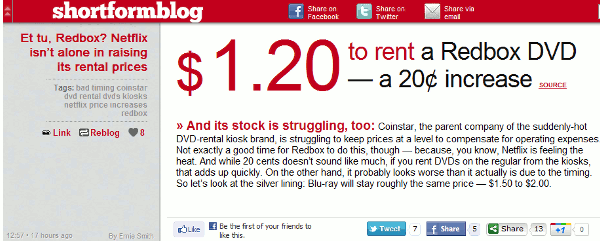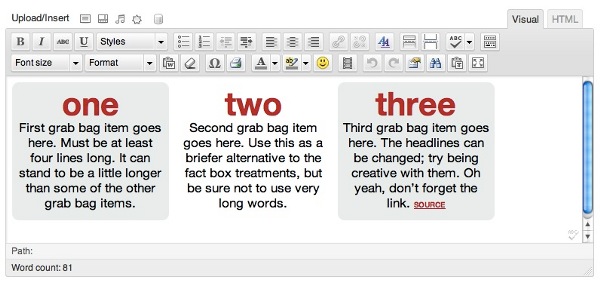On Tumblr and News Curation: Interview with Ernie Smith from ShortFormBlog
It’s no news that Tumblr is one of the fastest-growing networks. Latest data from Quantcast indicate that it receives 410,180,736 visits every month, mostly young audiences with a desperate hunger for content and a strong community feel. This hybrid between blogging platform and social network is also a great and open field for new experiences in journalism and news curation. Traditional media conglomerates are trying to gain space here, but the most innovative ideas are coming from independent projects like ShortFormBlog, a successful site that takes advantage of the features of Tumblr. Its motto is crear: “Read a Little. Learn a Lot.” Ernie Smith, who created the page back in 2009, answers to my questions via email, while posting in ShortFormBlog and designing pages for his other job in a Gutenberg-style newspaper.
Why did you create ShortFormBlog and what was your inspiration?
ShortFormBlog’s roots come from a paper I used to work at a few years ago called Link, a free tabloid that The Virginian-Pilot, based in Norfolk, Va., ran. Link has a lot in common with this paper called RedEye that the Chicago Tribune runs, with one major difference: It had a really interesting editing style, where we cut down long stories to small, easy-to-read bites with lots of visuals — numbers, quotes, blurbs, and clever breakdowns. It was a great paper loved by the community, and as a designer, it was exactly the kind of thing I wanted to do.
But the paper didn’t make it through the financial crisis. It was too far from profitability, and it closed in December of 2008. A real bummer. Rather than being totally heartbroken about my favorite job going away (and kinda waiting to find out about a job I’d just interviewed for), I decided to take a stab at this crazy idea I had in my head, of doing a blog that focused on brevity and design over long blurbs. I gave myself two weeks to pull it off — a bit ambitious seeing that I hadn’t done. I met my deadline. On January 1, 2009, I threw it online. On January 8, I got the job. I’ve done both ever since.

When SFB started on WordPress, it was mostly a proof of concept — an experiment, a way to show how a visually-oriented news site could work. After working on it for a while, it hit me that there wasn’t a community building around the idea. I think the big downfall for independent publishers is the difficulty in building a community around their content, especially in the wake of things like Twitter and Facebook Pages, which have the effect of decentralizing communities away from content. It’s easier to latch onto something else.
One day, a reader noted to me that I should look at Tumblr, saying that my content would be a good fit there. So, after playing with a few ideas, I decided to custom-build a Tumblr theme and to see what happened. We ran both for about four or five months. Within a couple months, it became clear that two things were happening: 1) It was starting to take off (roughly 15,000 followers in a year), and 2) A strong news-oriented community was building up on Tumblr. By February, it was clear the WordPress page wasn’t where the action was happening, so we moved to Tumblr fully and haven’t looked back.
You will not find a more vibrant community on the internet than the Tumblr community; it’s one that flows in many directions and is full of passion about everything, from random memes to truly serious issues. That’s the best part of the site. Everything around it just facilitates the growth of that often-creative, often-brilliant community.
How did you build the design of the page?
The idea started with the design, really. I wanted to create a format that was versatile for quick storytelling, but would look different with each post. So, you look at a quote, and then you see some numbers, then you see some blurbs, and then you see a photo. Keeping a visually-dynamic design has been a huge priority for me, and I’ve tried doing it by keeping a tight leash on the design, as well as being willing to take new risks with it.
We used to use databases for all the styles, but that got too clunky, so I came up with a super-versatile system for us — unordered lists that rely on simple HTML and complex CSS. If you want to change the style, just change the class. It’s worked well for us over the past couple of years.
Now, Tumblr isn’t perfect, from a technical perspective. It’s easily hackable, to a point. What SFB does is beyond that point, at least a little bit. So, as a result, we still keep a customized WordPress backend around to help with our more design-intensive content, as well as to keep a database of old posts (we have roughly 14,000 archived posts on our WordPress site alone). Using a backend allows us to design our posts visually, rather than using HTML and simply guessing on every post.

Ernie attached a screenshot to give us an idea of what he works with: "We have roughly a dozen post styles on top of the ones that Tumblr itself offers. In a way, we're stretching the platform in a different direction."
What are the main differences between ShortFormBlog and a traditional news media outlet?
The most important thing is the pivot — the idea of the blog is broad enough that we can make stuff up as we go along. One day we might be a breaking news outlet, another day we’ll be the opinion page and another day after that we might be the place to go for serious analysis or conversation. The effect is that we’re a little all over the place, but you’re guaranteed to get a bit of a mix from us. We don’t do much reporting, but we instead focus on aggregating content. Whether it’s finding a photo or a video from the scene of a big story before anyone else, giving a drab economic story a fresh coat of paint, pontificating like Jay Rosen or Andrew Sullivan, or cracking wise on Herman Cain, the mix is what matters.
We do this all with a small staff, so we’re not perfect, but we think it works well for us. There’s a little bit of opinion in the mix, too. With this type of content, opinions have a great way of taking the content and turning it into something with a touch of emotion. I think people want snark from a site like this, they want perspective, they want direction. We try hard to make that content fascinating. :)
Could you tell us about the page stats? How many visitors or page views do you have?
As I mentioned, we have roughly 15,000 followers on Tumblr, give or take a few, as well as a few thousand Twitter followers and a network of Facebook and Google+ followers, too. Tumblr’s a weird beast — a lot of the traffic heads through the dashboard, so the page itself is not a target of traffic, usually. Our reach, as a result is probably less focused on traffic than most traditional sites. I’d say we get between 40,000 and 50,000 unique visitors a month, some months doing better than others. Our traffic tends to ebb and flow based on the news cycle.
A friend once told me that my style is not something that goes viral quickly. I’m not going after the Buzzfeed market (though I love those guys). I’m going after something headier and more serious. As a result, I have to fight for my readers and build them one by one. I think we’ve done a great job of that over the past few years. I think there’s still much to do, though.
Do you know what kind of news are more appealing to your readers? What stories have been the most successful so far?
The types of posts I find work best fit into three categories: 1) Political posts, 2) Breaking news and 3) Fact-checking. The first tends to catch the passions of people, especially if we can explain it well. The second is a way that we can stand out by offering information before anyone else has it. The third one is interesting — what tends to happen during breaking news is that a piece of information will propagate due to its viral nature, and most people will accept it without turning on their Spidey-sense. What we try to do is research stuff and prove whether or not it’s correct. Sometimes a photo will gain traction during a natural disaster, and correcting the record is a way to build trust with your reader. I’m of the opinion that a real-time fact-checking site (like Snopes, but faster) could be a real hit.
We do some liveblogging, which tends to be popular, especially our debates with DC Decoder. One example:
http://shortformblog.tumblr.com/tagged/cnndebate/chrono
We also tend to do more in-depth things from time to time that do well, such as:
http://shortformblog.tumblr.com/post/7958165012/norway-oslo-update-package
http://shortformblog.tumblr.com/post/7828548123/news-of-the-world-hacking (two examples of our Tumbl-zine style, which uses Tumblr’s photoset to do magazine layouts)
http://shortformblog.tumblr.com/post/9301851473/u-s-fault-lines-nuclear-graphic (a graphic pointing out fault lines vs. nuclear power plants, which came in handy during the DC quake earlier this year)
How many people collaborate with ShortFormBlog at the moment?
We have about four regular writers, including myself, as well as an occasional contributor. One of my writers, Seth Millstein, got a job with The Daily (the iPad-only newspaper) based in part on the work he’s done with the blog, and our occasional contributor, Matthew Keys, is a well-known Twitter curator best known as @ProducerMatthew.
We all bring different things to the content. I tend to do a lot of media analysis-type stuff and posts about technology. Seth and Chris Tognotti tend to do a lot with politics. Sami Main does a lot of slice-of-life, fun stuff. It plays into the whole thing I’ve always said, which is that having a little bit of everything, including opinion, makes for an appealing stew. Everybody brings something to the content, and that’s hugely important.
What other journalistic projects are you interested in?
Well, beyond my job as a designer at the Washington Post Express (yeah, I still have an ink-stained hand in print), I have some strong interests in breaking news. I think there is a lot of untapped potential for making breaking news into something that the community plays a strong hand in propagating. I’m looking at (and thinking about) ideas for this right now, and I hope in the next few months to act on them.
I’m also looking for new curation tools all the time. I think that there is a market for a really slick curation tool that takes twelve steps of blogging down to two or three. My current favorite is Clipboard; I also like Percolate a lot. I think the thing about news is that good curation is really important to understanding all this crazy stuff happening around us. You need direction and focus, or you won’t know where to start. You might miss something. Good curation is all about surfacing things you might’ve missed.